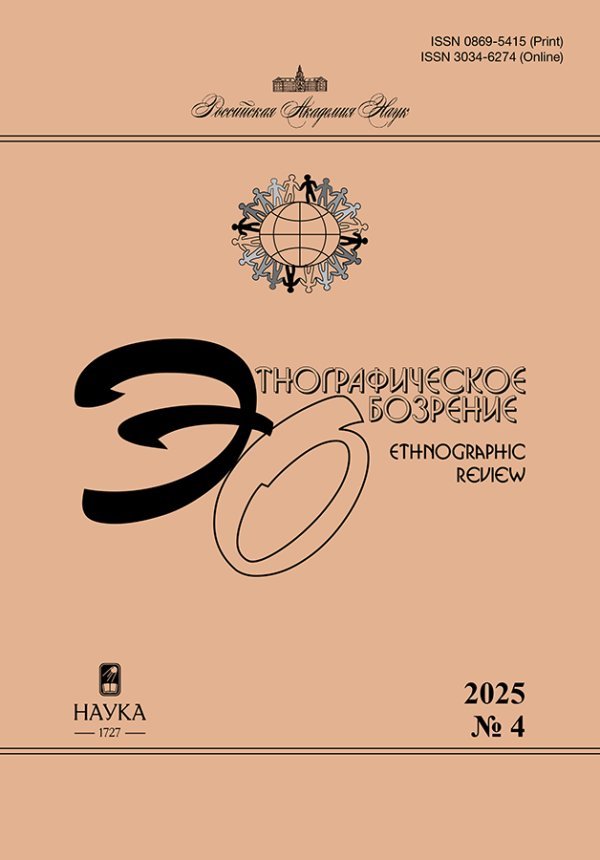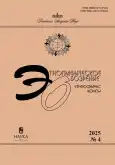Irish Dance in the Modern World: Setting of Pub, Competition, and Stage
- Authors: Glazovskaya A.A.1
-
Affiliations:
- independent researcher
- Issue: No 4 (2025)
- Pages: 57-73
- Section: Special Theme of the Issue: Ethnography of Performing Arts (guest editor S.I. Ryzhakova)
- URL: https://stomuniver.ru/0869-5415/article/view/697015
- DOI: https://doi.org/10.31857/S0869541525040052
- ID: 697015
Cite item
Abstract
Ireland’s image in mass culture is closely associated with Irish dances, which are one of the country’s distinctive symbols. As a result of the success of the touring dance show “Riverdance” in 1994, Irish dances have long ceased to be considered to be only “Irish”. The Irish Dance World Championships are attended by over 6,000 dancers from around 30 countries. Riverdance still remains one of Ireland’s most profitable export products. The dance form that we see today on the stage, associated with Ireland, was developed at the beginning of the 20th century. This was a result of the country's quest for independence. Since then, however, its functions have changed in the modern world. When this dance became widely known on the global stage during a period of economic boom (the effect referred to as the Celtic Tiger), it became a reflection of global “western” trends that were completely opposed to established notions of how the dance should be performed: “past, catholic, rural” has been modified into a Broadway-style performance. This article investigates how a local cultural phenomenon, which is considered “folk dance” on stage, became an object of commodification in the 21st century, as well as the changes it has undergone (and continues to undergo).
Keywords
About the authors
A. A. Glazovskaya
independent researcher
Author for correspondence.
Email: a.glazovskaya@icloud.com
ORCID iD: 0000-0002-9823-5160
Moscow, Russia
References
- Abashin, S., and O. Brednikova, eds. 2021. Zhit’ v dvuh mirah: pereosmysliaia transnatsionalizm i translokal’nost’ [To Live in Two Worlds: Rethinking Transnationalism and Translocality]. Moscow: NLO.
- Appadurai, A. 1996. Modernity at Large: Cultural Dimensions of Globalization. Minneapolis: University of Minnesota Press.
- Bramwell, R. and J. Butterworth. 2019. “I Feel English as Fuck”: Translocality and the Performance of Alternative Identities through Rap. Ethnic and Racial Studies 42 (14): 2510–2527. https://doi.org/10.1080/01419870.2019.1623411
- Brennan, H. 1994. Reinventing Tradition: The Boundaries of Irish Dance. History Ireland 2 (2): 22–24.
- Brennan, H. 2022. The Story of Irish Dance. Guilford: Lyons Press.
- Buck-Pavlick, H. 2021. Examining the Book: How Perception, Power, and Practice Altered Memory of Irish Ceili Dances. Journal of Music and Dance 11 (1): 1–9. https://doi.org/10.5897/jmd2020.0082
- Carr, D.E. 2001. On the Heels of Riverdance: Choreographic Process in Contemporary Irish Step Dance. PhD diss., Graduate School of the Texas Woman’s University. https://twu-ir.tdl.org/server/api/core/bitstreams/4ddc21e7-105f-4be5-84fd-dd6d14f00e93/content
- Farrell-Wortman, L. 2010. The Riverdance Phenomenon and the Development of Irish Identity in the Global Era. Studies in Musical Theatre 4 (3): 311–319. https://doi.org/10.1386/smt.4.3.311_1
- Foley, C. 2001. Perceptions of Irish Step Dance: National, Global, and Local. Dance Research Journal 33 (1): 34. https://doi.org/10.2307/1478855
- Foley, C. 2013. Step Dancing in Ireland: Culture and History. London: Routledge.
- Freitag, U., and A. Von Oppen. 2010. Introduction. “Translocality”: An Approach to Connection and Transfer in Area Studies. In “Translocality”: The Study of Globalising Processes from a Southern Perspective, edited by U. Freitag and A. Von Oppen, 1–21. Leiden: Brill, 2010. https://doi.org/10.1163/ej.9789004181168.i-452.8
- Giroux, H.A. 1998. Nymphet Fantasies: Child Beauty Pageants and the Politics of Innocence. Social Text 57: 31–53. https://doi.org/10.2307/466880
- Greiner, C., and P. Sakdapolrak. 2013. Translocality: Concepts, Applications and Emerging Research Perspectives. Geography Compass 7 (5): 373–384. https://doi.org/10.1111/gec3.12048
- Hoerburger, F. 1968. Once Again: On the Concept of ‘Folk Dance”. Journal of the International Folk Music Council 20: 30–32. https://doi.org/10.2307/836068
- Kytola, S. 2015. Translocality. In The Routledge Handbook of Language and Digital Communication, edited by A. Georgakopoulou and T. Spilioti. Routledge eBooks. New York: Routledge. https://doi.org/10.4324/9781315694344
- Laffan, M. 1999. Irish Nationalists: Politicians and Rebels. In The Resurrection of Ireland: The Sinn Féin Party, 1916–1923, by M. Laffan, 3–40. Cambridge: Cambridge University Press. doi: 10.1017/cbo9781139106849.003
- Masero, A. 2010. The Changes in Irish Dance Since Riverdance. Mahurin Honors College Capstone Experience/Thesis Projects: 234. https://digitalcommons.wku.edu/stu_hon_theses/234
- Narskii, I. 2018. Kak partiia narod tantsevat’ uchila, kak belletmeistery ei pomogali, i chto iz etogo vyshlo [How the Party Taught People to Dance, How Ballet Masters Helped It, and What Came Out of It]. Moscow: NLO.
- Shay, A. 1999. Parallel Traditions: State Folk Dance Ensembles and Folk Dance in “The Field”. Dance Research Journal 31 (1): 29. https://doi.org/10.2307/1478309
- Steffan, O. 2021. This is How We Dance: The Impact of Riverdance on Irish Step Dancing. Pennsylvania: Drexel University. https://doi.org/10.17918/73k2-rg85
- Welsch, W. 1999. Transculturality: The Puzzling form of Cultures Today. In Spaces of Culture: City, Nation, World, edited by M. Featherstone and S. Lash, 194–213. London: SAGE https://doi.org/10.4135/9781446218723.n11
- Wulff, H. 2007. Dancing at the Crossroads: Memory and mobility in Ireland. New York: Berghahn Books. https://doi.org/10.3167/9781845453282
- Wulff, H. 2014. Ballet Culture and the Market: A Transnational Perspective. In Dancing Cultures: Globalization, Tourism and Identity in the Anthropology of Dance, edited by H. Neveu Kringelbach and J. Skinner, 46–59. New York: Berghahn Books. http://su.diva-portal.org/smash/record.jsf?pid=diva2:570398
Supplementary files











